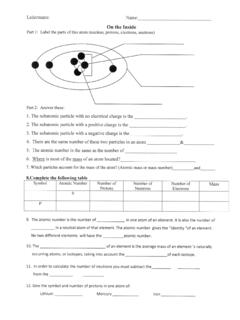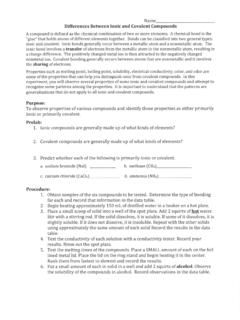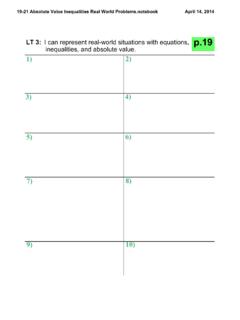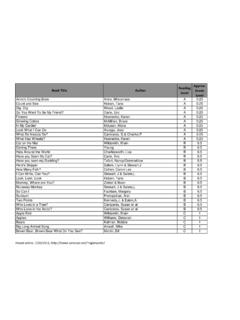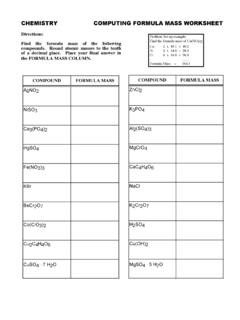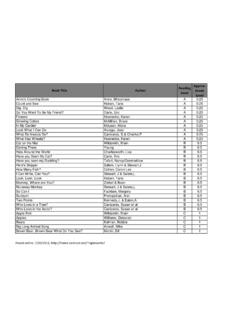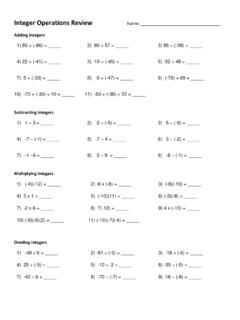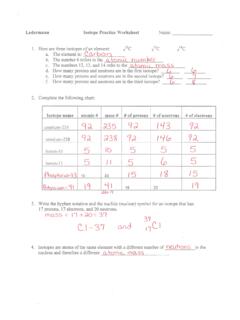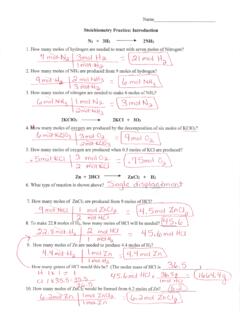Transcription of 10 Supreme Court Cases Every Teen Should Know - ISD 622
1 10 Supreme Court Cases Every Teen Should Know The nation's highest Court has had plenty to say about everything from free speech at school to teenagers' rights in the legal system. By Tom Jacobs For those of us on the outside, the Supreme Court can seem remote and mysterious. But the Court , whose nine Justices are appointed for life and deliberate in secret, exerts a powerful influence over the course of the nation and over the lives of Americans including teenagers. In a landmark 1967 case known as In re Gault ("in re" is Latin for "in reference to"), which concerned the arrest of a 15-year-old Arizona boy, the Court ruled that teenagers have distinct rights under the Constitution. (Prior to that, the law generally regarded children as the property of their parents). In the 40 years since, the Court has weighed in on a host of issues involving people under 18 from freedom of speech and privacy at school to the rights of teenagers in the legal system.
2 Part 1 of this two-part article looks at five Cases involving student protests, school searches, corporal punishment, school prayer, and the prosecution of juveniles in adult courts. Tinker v. Des Moines Independent School District (1969). Issue: Freedom of Speech at School Bottom Line: You Have the Right To Express Yourself Up to a Point Background In December 1965, John and Mary Beth Tinker and their friend Chris Eckhardt wore black armbands to school in Des Moines, Iowa, to protest the war in Vietnam. School officials told them to remove the armbands, and when they refused, they were suspended (John, 15, from North High; Mary Beth, 13, from Warren Harding Junior High; and Chris, 16, from Roosevelt High). With their parents, they sued the school district, claiming a violation of their First Amendment right of freedom of speech. Ruling The Supreme Court sided with the students. Students and teachers don't "shed their constitutional rights to freedom of speech or expression at the schoolhouse gate," the Court said.
3 The Court did not, however, grant students an unlimited right to self-expression. It said First Amendment guarantees must be balanced against a school's need to keep order: As long as an act of expression doesn't disrupt classwork or school activities or invade the rights of others, it's acceptable. Regarding the students in this case, "their deviation consisted only in wearing on their sleeve a band of black cloth," the Court said. "They caused discussion outside of the classrooms, but no interference with work and no disorder.". Impact In 1986, applying the "disruption test" from the Tinker case, the Supreme Court upheld the suspension of Matthew Fraser, a 17-year-old senior at Bethel High School in Tacoma, Washington, who gave a school speech containing sexual innuendos (Bethel School District v. Fraser). The Court said "it is a highly appropriate function of public school education to prohibit the use of vulgar and offensive terms in public discourse.
4 ". Lower courts have relied on Tinker in rulings on school attire, allowing nose rings and dyed hair, for example, but disallowing a T-shirt displaying a Confederate flag. In June, the Supreme Court weighed in on another student expression case, Frederick v. Morse, ruling that schools can limit student speech that seems to advocate illegal drug use. The case concerned Joseph Frederick, an 18-year-old senior at Juneau-Douglas High School in Alaska, who was suspended in 2002 for holding a banner that said "Bong Hits 4 Jesus" while standing across the street from the school during the Olympic torch relay. New Jersey v. (1985). Issue: Privacy Rights at School Bottom Line: Your Belongings Can Be Searched, But Not Arbitrarily Background (Terry), a 14-year-old freshman at Piscataway High School in New Jersey, was caught smoking in a school bathroom by a teacher. The principal questioned her and asked to see her purse. Inside was a pack of cigarettes, rolling papers, and a small amount of marijuana.
5 The police were called and Terry admitted selling drugs at school. Her case went to trial and she was found guilty of possession of marijuana and placed on probation. Terry appealed her conviction, claiming that the search of her purse violated her Fourth Amendment protection against "unreasonable searches and seizures.". Ruling The Supreme Court ruled in favor of the school. Students have "legitimate expectations of privacy," the Court said, but that must be balanced with the school's responsibility for "maintaining an environment in which learning can take place." The initial search of Terry's purse for cigarettes was reasonable, the Court said, based on the teacher's report that she'd been smoking in the bathroom. The discovery of rolling papers near the cigarettes in her purse created a reasonable suspicion that she possessed marijuana, the Court said, which justified further exploration. Impact is the landmark case on search and seizure at school.
6 Basically, school officials may search a student's property if they have a "reasonable suspicion" that a school rule has been broken, or a student has committed or is in the process of committing a crime. These are called "suspicion-based" searches. There are also "suspicionless searches" in which everyone in a certain group is subject to a search at school. Ingraham v. Wright (1977). Issue: School Discipline Bottom Line: Teachers Can Use Corporal Punishment, If Your locality Allows It Background James Ingraham, a 14-year-old eighth-grader at Drew Junior High School in Miami, was taken to the principal's office after a teacher accused him of being rowdy in the school auditorium. The principal decided to give him five swats with a paddle, but James said that he hadn't done anything wrong and refused to be punished. He was subsequently held down while the principal gave him 20 swats. While corporal punishment was permitted in the school district, James suffered bruises that kept him out of school for 10 days and he had to seek medical attention.
7 James and his mother sued the principal and other school officials, claiming the paddling violated Eighth Amendment protections against "cruel and unusual punishments.". Ruling The Supreme Court ruled against James. The Court said that reasonable physical discipline at school doesn't violate the Constitution. The Eighth Amendment, the Justices said, was designed to protect convicted criminals from excessive punishment at the hands of the government not schoolchildren who misbehave. The Court , however, did direct teachers and principals to be cautious and use restraint when deciding whether to administer corporal punishment to students. The Justices suggested that school officials consider the seriousness of a student's offense, the student's attitude and past behavior, the age and physical condition of the student, and the availability of a less severe but equally effective means of discipline. Impact The Court left the question of whether to allow corporal punishment up to states and local districts, which traditionally set most education policies.
8 Twenty-two states currently permit corporal punishment in public schools, and 28 have banned the practice. Santa Fe Independent School District v. Jane Doe (2000). Issue: School Prayer Bottom Line: Public schools Cannot Sponsor Religious Activity Background A Texas school district allowed a student "chaplain," who had been elected by fellow students, to lead a prayer over the public address system before home football games. Several students and their parents anonymously sued the school district, claiming a violation of what's known as the Establishment Clause of the First Amendment, which states that "Congress shall make no law respecting an establishment of religion, or prohibiting the free exercise thereof.". Ruling The Supreme Court ruled that the school district's policy regarding prayer was unconstitutional. Although led by students, the prayers were still a school-sponsored activity, the Court said, and they were coercive because they placed students in the position of having to participate in a religious ceremony.
9 "The Constitution demands that schools not force on students the difficult choice between attending these games and avoiding personally offensive religious rituals," the Court said. The Justices added that "nothing in the Constitution .. prohibits any public school student from voluntarily praying at any time before, during, or after the school day.". Impact Since the Santa Fe decision, several lower courts have held that student-initiated group prayer is protected under the First Amendment if it is not sponsored by the school. This is generally accepted to mean, for instance, that a group of student athletes could pray together before a game in the locker room, as long as the coach or other school officials are not involved. Kent v. United States (1966). Issue: Juveniles and Serious Crime Bottom Line: Teens Can Be Tried as Adults Background Morris Kent, 16, who had been on probation since he was 14 for burglary and theft, was arrested and charged with three home burglaries, three robberies, and two counts of rape in Washington, Because of the seriousness of the charges and Morris's previous criminal history, the prosecutor moved to try Morris in adult Court .
10 Morris's lawyer wanted the case to stay in juvenile Court where the penalties were much less severe. He had planned to argue that Morris had a mental illness that Should be taken into account when deciding where he would be tried. Without a hearing, the judge sided with the prosecutor and sent Morris to adult Court , where he was found guilty and sentenced to 30 to 90 years in prison. Morris appealed, arguing that the case Should have remained in juvenile Court . Ruling The Supreme Court ruled against Morris, and said that a minor can be tried and punished as an adult. However, the Justices said that in deciding whether to remove a case from juvenile Court , judges must weigh a variety of factors, including the seriousness of the crime; the juvenile's age; and the defendant's criminal background and mental state. Impact How the courts treat juveniles in the legal system varies from state to state. In many states, those under 18 can be tried as adults for crimes such as murder, sexual assault, or possession or sale of drugs, with punishments that range up to life in prison without the possibility of parole.

